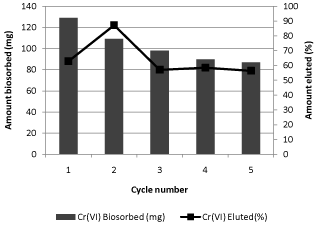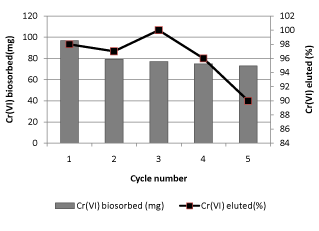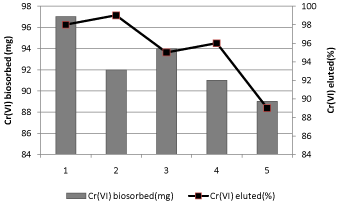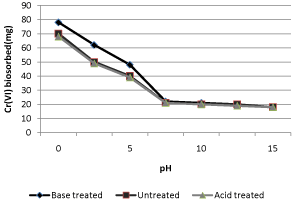| Research Article |
Open Access |
|
| Korrapati Narasimhulu1* and Y. Pydi Setty2 |
| 1Department of Biotechnology, National Institute of Technology, Warangal, India |
| 2Department of Chemical Engineering, National Institute of Technology, Warangal, India |
| *Corresponding authors: |
Korrapati Narasimhulu
Department of Biotechnology
National Institute of Technology
Warangal, India-506004
Tel: 919985470286
E-mail: simha_bt@nitw.ac.in |
|
| |
| Received April 26, 2012; Published July 25, 2012 |
| |
| Citation: Narasimhulu K, Setty YP (2012) Studies on Biosorption of Chromium Ions from Wastewater Using Biomass of Aspergillus niger. 1: 146. doi:10.4172/scientificreports.146 |
| |
| Copyright: © 2012 Narasimhulu K, et al . This is an open-access article distributed under the terms of the Creative Commons Attribution License, which permits unrestricted use, distribution, and reproduction in any medium, provided the original author and source are credited. |
| |
| Abstract |
| |
| The biosorption capacity of immobilized Aspergillus niger for Cr (VI) was found to depend on pH, contact time, biosorbent dose and initial concentration of Cr (VI). In this study, the maximum uptake of Cr (VI) was 93.4, 96.2 and 98.6 mg respectively at a pH 1.5 and with an increase in pH up to 11 the metal uptake decreased gradually up to 39.95, 52.35 and 66.48 mg respectively for acid treated, untreated and base treated fungal biosorbents. Increase in biosorbent dose up to 1 g of biomass and contact time up to 60 min resulted in an increase in biosorption from 20.2, 16.8 and 28.3 mg at a biosorbent dose of 0.1 g 100 ml-1 to 93.4, 96.2 and 98.6 mg at a biosorbent dose of 1.0 g 100 ml-1 and then further increase in adsorbent dose and contact time did not result in more Cr (VI) adsorption by per unit weight of biosorbent. The percentage metal uptake by the biosorbent was found to decrease upto 60.35, 50.64 and 82.5 percent respectively for acid treated, untreated and base treated fungal biosorbents at the 300 mgl-1 Cr (VI) ion concentration. The resulted data was found to fit well in Langmuir model of adsorption isotherm with a high value of correlation coefficient. The biosorbed metal was eluted from the biosorbent by using 0.1M H2SO4 as elutant. |
| |
| Keywords |
| |
| Biosorption; Aspergillus niger; Immobilization; Isotherm; Hexavalent chromium |
| |
| Introduction |
| |
| The main pollutant from industrial complexes is the effluent which contains heavy metals such as Cu, Ni, Zn, Pb, Cr, Hg, Cd etc. and various organic compounds such as phenols, formaldehyde etc. [1]. Wastewater usually contains about 5 ppm of chromium [2]. The recovery of heavy metals using conventional techniques is neither economical nor eco-friendly [3]. So, there is a continuous search for an economic and ecofriendly approach of heavy metals removal. In this endeavor, biosorption, a biological method of environmental control, has emerged as an alternative to conventional waste treatment facilities as it has advantages of low operating cost, effective in dilute solutions, generates minimum secondary waste, completes within a short time period and have no toxicity limits for heavy metals [4,5]. Biosorption is the process in which physico-chemical interaction between the charged surface groups of micro-organisms and ions in solution takes place by the process of complexation, ion exchange, microprecipitation etc [6]. Biosorption is attractive since naturally occurring biomass or spent biomass from various fermentation industries can be effectively utilized [7]. These advantages have served as potential incentives for promoting biosorption as viable cleanup technology for heavy metal pollution. Immobilization of biosorbent leads to its stability and it can be used repeatedly with ease for the process of adsorption/ desorption [2]. Biotechnological exploitation of biosorption technology depends on the efficiency of regeneration of biosorbent after metal desorption. Therefore, recovery of biosorbent by mild and cheap desorbing agents is desirable for regeneration of biomass for use in multiple biosorption cycles. In the light of these observations, studies on biosorption of Cr (VI) to immobilized fungal biomass were carried out in the present study. Aspergillus niger was used for the removal of Cr (VI) from electroplating industrial effluent and highlighted the prospects of its future uses as a biosorbent material for the Cr (VI) removal. |
| |
| Materials and Methods |
| |
| Characterization of industrial effluent and estimation of Cr (VI) |
| |
| Stock metal solutions of Cr (VI) were prepared by dissolving appropriate quantities of pure analytical grade metal salts in double distilled water. The stock solutions were diluted further with deionized distilled water to obtain working solutions of different concentrations. The effluent was collected from Hyderabad electroplating works, Hyderabad, which is an elecroplating industry. The effluent collected from industry, was analyzed for different physico-chemical properties such as total dissolved solids, hydrogen ion concentration, colour, oil and grease, Biological Oxygen Demand (BOD), Chemical Oxygen Demand (COD), sulphate, phosphate, chromium, copper, nickel ferrus and zinc (Table1). |
| |
|
|
Table 1: Physico-chemical properties of electroplating industrial effluent. |
|
| |
| The concentration of each component was determined as per the procedure outlined in APHA [8]. Chromium analysis was carried out by spectrophotometric method by using 1,5-Di-phenyl carbazide accoding to APHA [8]. The hexavalent chromium was determined colorimetrically by reaction with diphenylcarbazide in acid solution. A red-violet color was produced. The reaction was very sensitive, the absorptivity based on chromium being about 40000 lg-1 cm-1 at 540 nm wavelength. Aspergillus niger was previousely isolated from wastewater treatment plant of NIT Warangal and routinely maintained by streaking on a rose bengal agar medium and incubating at 25ºC. For mass culturing, liquid broth was used as a culture medium which was having the following composition (gl-1): Bactodextrose, 20; Bactopeptone, 10; NaCl, 0.2; CaCl2. 2H2O, 0.1; KCl, 0.1; K2HPO4, 0.5; NaHCO3, 0.05; MgSO4, 0.25 and FeSO4. 7H2O, 0.005. The liquid phase pH was adjusted to 4.5 by using the 0.1M HCl and 0.1N NaOH. The sterile liquid broth was inoculated with a loop of culture grown on rose bengal agar medium and incubated on an orbital shaker at 125 rpm and 25ºC for five days in 250 ml conical flasks. The biomass produced was collected by vacuum filtration and washed twice with extra pure double distilled water. The washed biomass was dried at 60ºC in an oven and dry material was ground and sieved through 100 mm screen. In order to generate active sites and enhance the metal biosorption capacity, one gram of dry biomass was conditioned in batches by treatment with suitable amount of 0.1M H2SO4 and 0.1N NaOH for 30 min at 60ºC. The treated biomass was collected by centrifugation and washed twice with extra pure double distilled water. After washing, the biomass was dried at 60oC in an aluminum foil till the weight of biomass became constant. It was then ground and sieved through a screen with pore size of 100 mm and stored at 60ºC. |
| |
| Immobilization of biosorbent and batch studies |
| |
| The dried fungal biomass was immobilized in calcium-alginate matrix to establish a simple and cost effective granulation of the biomass. The immobilization of fungal biosorbent via entrapment was carried out as follows: 3% (w/v) sodium-alginate was dissolved in distilled water and mixed with 5% (w/v) of fungal biosorbent. The mixture was stirred for 1 hr at 30ºC and then, the slurry solution was dripped through a nozzle into 4% (w/v) CaCl2 solution [9]. Durable, spherical beads containing biomass were formed immediately by a phase inversion process as the alginate was crosslinked by Ca2+. Bead size varied according to the diameter of injection nozzle. The gel beads with size 3.2 mm ± 0.1 mm, were moderately agitated in the double distilled water for 2 hr at 4ºC. The curing procedure hardened the beads and resulted in the formation of a favourable micro-porous structure. Finally, the beads were stored at 4ºC in ultrapure double distilled water until further use. The batch adsorption studies (100 ml) were carried out in triplicate in the 250 ml conical flasks at temperature 28ºC ± 0.15ºC [2]. The incubated shaker was used for batch studies at 150 rpm. A predetermined amount of biosorbent was mixed with 100 ml of heavy metal solutions in 250 ml conical flasks. After a desired contact period conical flasks were removed and the solutions were filtered through Whatman filter paper 42 and the filtrate was analyzed for residual Cr (VI) concentration. The Cr (VI) removal affinity of biosorbent was determined from batch experiments as a function of contact time, pH, biosorbent dosage and initial concentration of metal ions. The adsorption data was analyzed by employing Langmuir adsorption isotherm. |
| |
| Metal desorption and biosorbent reutilization |
| |
| The biosorbent was prior exposed to metal solutions under optimum conditions for metal desorption assays, as described above and then separated [2]. The metal loaded biosorbent was incubated for 1 hr at 28ºC with 50 ml of 0.1M H2SO4 in a rotary shaker for continuous stirring at 150 rpm. The solution was then filtered through Whatmann filter paper 42 and the filtrate was used to determine the metal released. The total desorbed metal was established by comparing the metal released to the amount of metal previously adsorbed to the biosorbent. All experiments were run in triplicates. The metal stripped biosorbent was rinsed twice with 50 ml of ultrapure double distilled water for 15 min. The acid treated and base treated biomass was activated by treating them with 0.1M H2SO4 and 0.1N NaOH respectively for 30 min at 150 rpm. The resulting biomass was then reloaded with metal solutions as described above and the desorption treatment was repeated. |
| |
| Adsorption isotherm |
| |
| Equilibrium occurring during adsorption at a definite concentration range could be represented by Langmuir isotherm for adsorption [10]. The equilibrium data was analyzed with the help of Langmuir adsorption isotherm. The Langmuir equation is given by, |
| |
 |
| |
| Where, Qe is the amount of metal adsorbed per unit mass of biosorbent (mgg-1), Qmax and b are Langmuir constants and Ce is the equilibrium concentration of metal ion (mgl-1). The value of r2 (correlation coefficient) showed that the adsorption data for Cr (VI) was fitted well into Langmuir adsorption isotherm. |
| |
| The Langmuir model assumes about constant adsorption energy. The agreement of the experimental data with the model showed that constant adsorption energy existed for the experimental conditions. The essential characteristics of Langmuir isotherm can be expressed in terms of dimensionless constant, RL [10] separation factor for equilibrium parameter, which is defined by |
| |
 |
| |
| Where Ci is the initial concentration of metal ion (mgl-1) and b is Langmuir constant (mgl-1). The RL values obtained in the present studies for different metal ions indicated favorable adsorption on the biosorbent surface. Thus, heavy metal removal by A. niger is considered to be a chemical, equilibrated and site specific mechanism on the biosorbent surface. |
| |
| Free energy change (ΔG) was calculated using the following equation: |
| |
 |
| |
| Where, ΔG: Free energy change; R: Universal gas costant; T: Absolute temperature; b: Langmuir constant. |
| |
| Results and Discussion |
| |
| Characterization of industrial effluent |
| |
| The turbid effluent with dark green colour was found to be odorless (Table 1). The amount of chromium was found to be higher than Central Pollution Control Board standards, which possess a great threat to the ecosystem. The main form of the metal present in the effluent was Cr(VI). |
| |
| Effect of pH and biomass dose: Experiments were conducted with 1 g biomass dose of biosorbent for a contact time of 60 min. The pH varied from 1.5 to 11 with the help of 0.1M H2SO4 and 0.1N NaOH. The results showed that the metal uptake was optimum at pH 1.5. Further increase in pH beyond optimal value (1.5) resulted in decrease of metal uptake. This observation agrees with the earlier reports on Cr (VI) removal by different biosorbents. As the pH of the system increases, the number of negatively charged sites increases and the number of positively charged sites decreases. A negatively charged surface site on the adsorbent does not favour the adsorption of anions due to the electrostatic repulsion. The optimum pH from above experiments with contact time of 60 minutes was kept to find the optimum dose of biomass. Various doses (0.1 to 1.2 g) of biomass were tested for Cr (VI) removal from synthetic solutions of 100 mgl-1 concentration. 1 g of biomass dose was sufficient for the optimum removal of Cr (VI) ions. Increase in biomass dose after optimum value did not show corresponding increase in the metal ion uptake from the solution. Interaction of biosorbent and metal ions is generally electrostatic in nature on the binding sites present on the surface of biosorbent. For a given constant biosorbent concentration, the initial metal ion adsorption increased up to the stage of saturation of all the binding sites and further increase in the dose of biosorbent did not change the metal adsorption to biomass ratio. |
| |
| |
| Rate of adsorption: Relationship between contact time and Cr (VI) removal was investigated by using immobilized biosorbent with 1 g biomass dose of each. The pH of the 100 mgl-1 Cr (VI) solution was adjusted to 1.5. The maximum amount of Cr (VI) uptake was observed after 60 min. Increase in contact time from 60 to 180 min did not result in corresponding increase in uptake capacity of biosorbent. It was observed that biosorption is a rapid process as most of the adsorption (80-85%) was completed in the initial 45 min. These results indicated that the adsorption sites were bind up in the initial 60 min by the metal ions passively. After this, the increase in contact time might not help for more adsorption of metal ions with this biosorbent. As a result, 60 min was chosen as optimum contact time for further studies. |
| |
| Effect of initial metal ion concentration on rate of adsorption of Cr (VI): The uptake of metal ions was observed for different initial ion concentration of Cr (VI) at optimum contact time and biosorbent dose. The results revealed that an increase in metal ion concentration resulted in gradual decrease in percent biosorption of Cr (VI) up to 100 mgl-1 and after that a sharp decrease in metal uptake percentage. An increase in initial concentration of metal ions resulted in the lowering of metal ion uptake due to reduction in ratio of sorptive surface to ion concentration. |
| |
| Adsorption isotherm |
| |
| It was found to be linear over a wide range of concentration. Langmuir constants ‘Qmax’ which is a measure of adsorption capacity expressed in mg g-1 and ‘b’ which is a measure of energy of adsorption expressed in mgl-1 were calculated from the slope and intercept of plots are shown in Table 2. |
| |
|
|
Table 2: Constants and correlation coefficient for immobilized Aspergillus niger. |
|
| |
| The values of ΔG (Table 2) observed to be negative, thus, indicating the spontaneous and exothermic nature of the adsorption process. The higher negative values reflect a more energetically favorable adsorption process. |
| |
| Reutilization of biosorbent: The total amount of metal biosorbed and desorbed in each subsequent cycle by immobilized biosorbents was calculated as shown in Figures 1, 2 and 3. The amount of Cr (VI) adsorbed in the 5th cycle was comparable to the first cycle. Also, the amount of metal desorbed after each loading cycle corresponded well to the amount of metal biosorption, which showed that a complete elution took place. Performance of immobilized biosorbent in industrial effluent: The batch study was carried out with 100 ml industrial effluent at 28 ± 0.15ºC and 150 rpm in 250 ml Erlenmeyer flasks. Immobilized biosorbent with a biomass dose of 1 g was used for a contact period of 40 minutes and it was found that biosorption of Cr (VI) was less in industrial effluent as compared to single metal ion synthetic solutions as shown in Figure 4. This may be due to interference and binding of other metal ions to the binding sites which was not the case with single metal ion synthetic solutions as all the binding sites were available for just single metal species. Overall, the performance was good in present electroplating industrial effluent. The tendency of biosorbents for metal removal in the present effluent was found in order of base treated > untreated > acid treated. |
| |
|
|
Figure 1: Biosorption and desorption cycles for chromium removal by immobilized acid treated Aspergillus niger. |
|
| |
|
|
Figure 2: Biosorption and desorption cycles for chromium removal by immobilized untreated Aspergillus niger. |
|
| |
|
|
Figure 3: Biosorption and desorption cycles for chromium removal by immobilized base treated Aspergillus niger. |
|
| |
|
|
Figure 4: Removal of Cr (VI) from industrial effluent by immobilized base treated, untreated and acid treated Aspergillus niger. |
|
| |
| Conclusion |
| |
| The present study showed that base treated biosorbent performed better than acid treated and untreated biosorbent. The explanation offered is that the increase in the metal uptake may be due to unmasking of some of cellular groups, which cannot participate in the sorption process without the treatment of alkali [11] also found that alkali treatment of Aspergillus niger mycelia improved their capacity to chelate various metal ions [12], in trying to explain the increase in metal uptake by A. niger after NaOH treatment, thereby suggesting that the removal of certain polysaccharides from the cell wall by alkali treatment generates more accessible spaces within the b-glucan chitin skeleton, thus allowing more metal ions to be sequestered by this structure. Immobilization of biosorbent increases the efficiency and ease of handling the process. The effect of pH and the higher sorption capacity suggest the electrostatic attraction of metal ions onto the fungal surface. The favorable values of Langmuir constants, RL factor and ΔG showed that A. niger is a good option for the removal of Cr (VI) from electroplating industrial effluent. |
| |
| |
| References |
| |
- Rajendran P, Muthukrishnan J, Gunasekaran P (2003) Microbes in heavy metal remediation. Indian J Exp Biol 41: 935-944.
- Srinath T, Garg SK, Ramteke PW (2003) Biosorption and elution of chromium from immobilized Bacillus coagulans biomass. Indian J Exp Biol 41: 986-990.
- Sarkar S, Gupta A (2003) Treatment of chrome plating wastewater (Cr+6) using activated alumina. Indian J Environ Health 45: 73-82.
- Dadhich AS, Beebi SK, Kavitha GV (2004) Adsorption of Ni (II) using agrowaste, rice husk. J Environ Sci Eng 46: 179-185.
- Ahalya N, Kanamadi RD, Ramachandra TV (2007) Cr (VI) and Fe (III) removal using Cajanus cajan husk. J Environ Biol 28: 765-769.
- Mise SR, Rajamanya VS (2003) Adsorption studies of chromium (VI) on activated carbon derived from Sorghum vulgare (dried stem of Jowar). Indian J Environ Health 45: 49-58.
- Gupta R, Ahuja P, Khan S, Saxena RK, Mohapatra H (2000) Microbial biosorbents: Meeting challenges of heavy metal pollution in aqueous solutions. Curr Sci 78: 967-973.
- Eaton AD, Franson MAH (2005) Standard methods for the examination of water and wastewater (21st Edn). American Public Health Association, Washington D.C.
- Dong X (2004) A comparative study of Cu (II) biosorption on Ca-alginate and immobilized live and inactivated Cladosporium sp. J Environ Biol 25: 337-341.
- Dhar NR, Khoda AK, Khan AH, Bala P, Karim MF (2005) A study of effects of acid activated saw dust on the removal of different dissolved tannery dyes (acid dye) from aqueous solutions. J Environ Sci Eng 47: 103-108.
- Muzzarelli RA, Tanfani F, Scarpini G (1980) Chelating, film-forming, and coagulating ability of the chitosan-glucan complex from Aspergillus niger industrial wastes. Biotechnol Bioeng 22: 885-896.
- Leuf E, Prey T, Kubiceck CP (1991) Biosorption of zinc by fungal mycelial waste. Appl Microbiol Biotechnol 34: 688-692.
|
| |
| |




